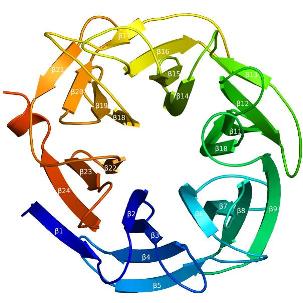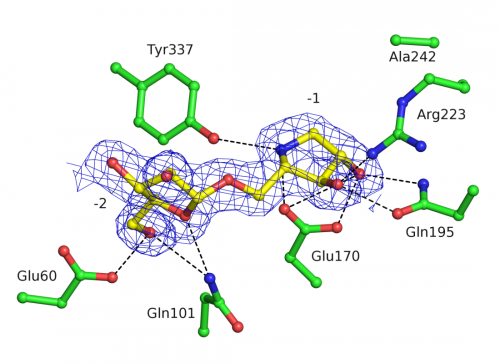CAZypedia celebrates the life of Senior Curator Emeritus Harry Gilbert, a true giant in the field, who passed away in September 2025.
CAZypedia needs your help!
We have many unassigned pages in need of Authors and Responsible Curators. See a page that's out-of-date and just needs a touch-up? - You are also welcome to become a CAZypedian. Here's how.
Scientists at all career stages, including students, are welcome to contribute.
Learn more about CAZypedia's misson here and in this article. Totally new to the CAZy classification? Read this first.
Difference between revisions of "Glycoside Hydrolase Family 93"
Harry Brumer (talk | contribs) (fixed references with respect to errors due to PubMed data (offending alpha symbol in Goddard-Borger ref.)) |
Harry Brumer (talk | contribs) (updated biblio reference tags to AuthorYear format to facilitate future editing) |
||
| Line 24: | Line 24: | ||
== Substrate specificities == | == Substrate specificities == | ||
| − | The characterized [[glycoside hydrolases]] of family GH93 are known to hydrolyse linear α-1,5-L-arabinan. <cite> | + | The characterized [[glycoside hydrolases]] of family GH93 are known to hydrolyse linear α-1,5-L-arabinan. <cite>Sakamoto2001 Carapito2009</cite>, EC:3.2.1-. |
| − | EC:3.2.1-. | ||
== Kinetics and Mechanism == | == Kinetics and Mechanism == | ||
| − | GH93 enzymes are [[exo]]-acting enzymes that only release arabinobiose from the non-reducing end of α-1,5-L-arabinan. These enzymes are proposed to be [[retaining]] enzymes based on the net retention of the configuration of the anomeric carbon is proposed from the products of the transglycosylation activity of the protein Abnx from ''Penicillium chrysogenum'' <cite> | + | GH93 enzymes are [[exo]]-acting enzymes that only release arabinobiose from the non-reducing end of α-1,5-L-arabinan. These enzymes are proposed to be [[retaining]] enzymes based on the net retention of the configuration of the anomeric carbon is proposed from the products of the transglycosylation activity of the protein Abnx from ''Penicillium chrysogenum'' <cite>Sakamoto2004</cite>. This proposal obtained support from the crystal structures of the Arb93A enzyme from ''Fusarium graminearum'' and Abnx both in complex with arabinobiose <cite>Carapito2009 Sogabe2011</cite>. α-L-Arabinofuranosylated pyrrolidines were shown to be good inhibitors of Arb93A. The Arb93A complex structure with a deoxyiminosugar equivalent of arabinobiose revealed a <sup>4</sup>T<sub>N</sub> twist conformation expected for the Michaelis complex, as seen for several retaining GH51 α-L-arabinofuranosidases. <cite>GoddardBorger2011</cite> |
== Catalytic Residues == | == Catalytic Residues == | ||
| − | From the crystal structure of Arb93A, Glu170 and Glu242 are proposed to act as [[catalytic nucleophile]] and [[general acid/base]] respectively. Mutagenesis experiment support their role in catalysis and they are strictly conserved among the family members. <cite> | + | From the crystal structure of Arb93A, Glu170 and Glu242 are proposed to act as [[catalytic nucleophile]] and [[general acid/base]] respectively. Mutagenesis experiment support their role in catalysis and they are strictly conserved among the family members. <cite>Carapito2009</cite> Recent structures and mutagenesis studies for the arabinanase Abnx from ''Penicillium chrysogenum 31B'' strengthened this assignment. Mutations to alanine or glutamine of their equivalent Glu174 and Glu246 lead to inactive enzyme. <cite>Sogabe2011</cite> |
== Three-dimensional structures == | == Three-dimensional structures == | ||
| − | The crystal structure of Arb93A reveals a six-bladed β-propeller fold characteristic of sialidases of [[clan]] GH-E. <cite> | + | The crystal structure of Arb93A reveals a six-bladed β-propeller fold characteristic of sialidases of [[clan]] GH-E. <cite>Carapito2009 Sogabe2011</cite>, The catalytic machinery is however very different from that of sialidases. <cite>Gaskell1995</cite> |
[[Image:Overalla4.jpg|Arb93A]] | [[Image:Overalla4.jpg|Arb93A]] | ||
| Line 42: | Line 41: | ||
'''First sterochemistry determination''' | '''First sterochemistry determination''' | ||
| − | This was determined with the ''Penicillium chrysogenum'' Abxn enzyme using <sup>1</sup>H-NMR to identify the transglycosylation products <cite> | + | This was determined with the ''Penicillium chrysogenum'' Abxn enzyme using <sup>1</sup>H-NMR to identify the transglycosylation products <cite>Sakamoto2004</cite> |
'''First [[catalytic nucleophile]] identification''' | '''First [[catalytic nucleophile]] identification''' | ||
| − | This was proposed based on the structure of ''Fusarium graminearum'' Arb93A <cite> | + | This was proposed based on the structure of ''Fusarium graminearum'' Arb93A <cite>Carapito2009</cite> |
'''First [[general acid/base]] residue identification''' | '''First [[general acid/base]] residue identification''' | ||
| − | This was proposed based on the structure of ''Fusarium graminearum'' Arb93A <cite> | + | This was proposed based on the structure of ''Fusarium graminearum'' Arb93A <cite>Carapito2009</cite> |
'''First 3-D structure''' | '''First 3-D structure''' | ||
| − | Determined for ''Fusarium graminearum'' Arb93A by Carapito and co-workers <cite> | + | Determined for ''Fusarium graminearum'' Arb93A by Carapito and co-workers <cite>Carapito2009</cite> |
== References == | == References == | ||
<biblio> | <biblio> | ||
| − | # | + | #Sakamoto2001 pmid=11425761 |
| − | # | + | #Carapito2009 pmid=19269961 |
| − | # | + | #Sakamoto2004 pmid=15342117 |
| − | # | + | #Sogabe2011 pmid=21543843 |
| − | # | + | #GoddardBorger2011 Goddard-Borger ED, Carapito R, Jeltsch JM, Phalip V, Stick RV, Varrot A. ''α-L-Arabinofuranosylated pyrrolidines as arabinanase inhibitors''. Chem Commun 2011 Sep 14;47(34):9684-9686. //''Note: Due to a problem with PubMed data, this reference is not automatically formatted. Please see these links out:'' [http://dx.doi.org/10.1039/C1CC13675E DOI:10.1039/C1CC13675E] [http://www.ncbi.nlm.nih.gov/entrez/query.fcgi?cmd=Retrieve&db=pubmed&dopt=Abstract&list_uids=21773614 PMID: 21773614] |
| − | # | + | #Gaskell1995 pmid=8591030 |
</biblio> | </biblio> | ||
| + | |||
<!-- DO NOT REMOVE THIS CATEGORY TAG! (...but please delete the nowiki tags before saving.) --> | <!-- DO NOT REMOVE THIS CATEGORY TAG! (...but please delete the nowiki tags before saving.) --> | ||
[[Category:Glycoside Hydrolase Families|GH093]] | [[Category:Glycoside Hydrolase Families|GH093]] | ||
Revision as of 02:56, 10 September 2011
This page has been approved by the Responsible Curator as essentially complete. CAZypedia is a living document, so further improvement of this page is still possible. If you would like to suggest an addition or correction, please contact the page's Responsible Curator directly by e-mail.
| Glycoside Hydrolase Family GH93 | |
| Clan | GH-E |
| Mechanism | retaining |
| Active site residues | known |
| CAZy DB link | |
| https://www.cazy.org/GH93.html | |
Substrate specificities
The characterized glycoside hydrolases of family GH93 are known to hydrolyse linear α-1,5-L-arabinan. [1, 2], EC:3.2.1-.
Kinetics and Mechanism
GH93 enzymes are exo-acting enzymes that only release arabinobiose from the non-reducing end of α-1,5-L-arabinan. These enzymes are proposed to be retaining enzymes based on the net retention of the configuration of the anomeric carbon is proposed from the products of the transglycosylation activity of the protein Abnx from Penicillium chrysogenum [3]. This proposal obtained support from the crystal structures of the Arb93A enzyme from Fusarium graminearum and Abnx both in complex with arabinobiose [2, 4]. α-L-Arabinofuranosylated pyrrolidines were shown to be good inhibitors of Arb93A. The Arb93A complex structure with a deoxyiminosugar equivalent of arabinobiose revealed a 4TN twist conformation expected for the Michaelis complex, as seen for several retaining GH51 α-L-arabinofuranosidases. [5]
Catalytic Residues
From the crystal structure of Arb93A, Glu170 and Glu242 are proposed to act as catalytic nucleophile and general acid/base respectively. Mutagenesis experiment support their role in catalysis and they are strictly conserved among the family members. [2] Recent structures and mutagenesis studies for the arabinanase Abnx from Penicillium chrysogenum 31B strengthened this assignment. Mutations to alanine or glutamine of their equivalent Glu174 and Glu246 lead to inactive enzyme. [4]
Three-dimensional structures
The crystal structure of Arb93A reveals a six-bladed β-propeller fold characteristic of sialidases of clan GH-E. [2, 4], The catalytic machinery is however very different from that of sialidases. [6]
Family Firsts
First sterochemistry determination
This was determined with the Penicillium chrysogenum Abxn enzyme using 1H-NMR to identify the transglycosylation products [3]
First catalytic nucleophile identification This was proposed based on the structure of Fusarium graminearum Arb93A [2]
First general acid/base residue identification This was proposed based on the structure of Fusarium graminearum Arb93A [2]
First 3-D structure Determined for Fusarium graminearum Arb93A by Carapito and co-workers [2]
References
- Sakamoto T and Thibault JF. (2001). Exo-arabinanase of Penicillium chrysogenum able to release arabinobiose from alpha-1,5-L-arabinan. Appl Environ Microbiol. 2001;67(7):3319-21. DOI:10.1128/AEM.67.7.3319-3321.2001 |
- Carapito R, Imberty A, Jeltsch JM, Byrns SC, Tam PH, Lowary TL, Varrot A, and Phalip V. (2009). Molecular basis of arabinobio-hydrolase activity in phytopathogenic fungi: crystal structure and catalytic mechanism of Fusarium graminearum GH93 exo-alpha-L-arabinanase. J Biol Chem. 2009;284(18):12285-96. DOI:10.1074/jbc.M900439200 |
- Sakamoto T, Fujita T, and Kawasaki H. (2004). Transglycosylation catalyzed by a Penicillium chrysogenum exo-1,5-alpha-L-arabinanase. Biochim Biophys Acta. 2004;1674(1):85-90. DOI:10.1016/j.bbagen.2004.06.001 |
- Sogabe Y, Kitatani T, Yamaguchi A, Kinoshita T, Adachi H, Takano K, Inoue T, Mori Y, Matsumura H, Sakamoto T, and Tada T. (2011). High-resolution structure of exo-arabinanase from Penicillium chrysogenum. Acta Crystallogr D Biol Crystallogr. 2011;67(Pt 5):415-22. DOI:10.1107/S0907444911006299 |
-
Goddard-Borger ED, Carapito R, Jeltsch JM, Phalip V, Stick RV, Varrot A. α-L-Arabinofuranosylated pyrrolidines as arabinanase inhibitors. Chem Commun 2011 Sep 14;47(34):9684-9686.
Note: Due to a problem with PubMed data, this reference is not automatically formatted. Please see these links out: DOI:10.1039/C1CC13675E PMID: 21773614
- Gaskell A, Crennell S, and Taylor G. (1995). The three domains of a bacterial sialidase: a beta-propeller, an immunoglobulin module and a galactose-binding jelly-roll. Structure. 1995;3(11):1197-205. DOI:10.1016/s0969-2126(01)00255-6 |

